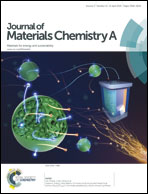Stable organic dyes based on the benzo[1,2-b:4,5-b′]dithiophene donor for efficient dye-sensitized solar cells†
Abstract
Two novel arylamine-free organic compounds (CYF1 and CYF2) incorporating a substituted benzo[1,2-b:4,5-b′]dithiophene unit as the electron donor were synthesized and used as sensitizers for dye-sensitized solar cells (DSSCs). The relationship between the chemical structure and photovoltaic performance was investigated. A higher molar absorption coefficient, longer electron lifetime, and larger adsorption amount were observed for sensitizer CYF1, which contains a single π bridge and anchoring unit, compared with CYF2 with twin π bridges and anchoring units. As a result, under standard global AM 1.5 solar conditions, the device based on CYF1 sensitizer gave a higher conversion efficiency of 8.02% than that based on CYF2. This is the highest value for amine-free organic sensitizers with no strong donor units. Moreover, the CYF1- and CYF2-sensitized DSSCs exhibited excellent stability under 1000 W m2 light soaking at 60 °C for 600 h. This is the first example of organic sensitizers based on benzo[1,2-b:4,5-b′]dithiophene donors for efficient dye-sensitized solar cells.
![Graphical abstract: Stable organic dyes based on the benzo[1,2-b:4,5-b′]dithiophene donor for efficient dye-sensitized solar cells](/en/Image/Get?imageInfo.ImageType=GA&imageInfo.ImageIdentifier.ManuscriptID=C5TA00332F&imageInfo.ImageIdentifier.Year=2015)

 Please wait while we load your content...
Please wait while we load your content...